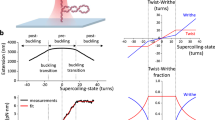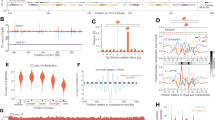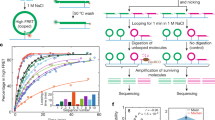Abstract
As RNA polymerase II (Pol II) transcribes a gene, it encounters an array of well-ordered nucleosomes. How it traverses through this array in vivo remains unresolved. One model proposes that torsional stress generated during transcription destabilizes nucleosomes ahead of Pol II. Here, we describe a method for high-resolution mapping of underwound DNA, using next-generation sequencing, and show that torsion is correlated with gene expression in Drosophila melanogaster cells. Accumulation of torsional stress, through topoisomerase inhibition, results in increased Pol II at transcription start sites. Whereas topoisomerase I inhibition results in increased nascent RNA transcripts, topoisomerase II inhibition causes little change. Despite the different effects on Pol II elongation, topoisomerase inhibition results in increased nucleosome turnover and salt solubility within gene bodies, thus suggesting that the elongation-independent effects of torsional stress on nucleosome dynamics contributes to the destabilization of nucleosomes.
This is a preview of subscription content, access via your institution
Access options
Subscribe to this journal
Receive 12 print issues and online access
$209.00 per year
only $17.42 per issue
Buy this article
- Purchase on SpringerLink
- Instant access to full article PDF
Prices may be subject to local taxes which are calculated during checkout







Similar content being viewed by others
Accession codes
References
Cairns, B.R. The logic of chromatin architecture and remodelling at promoters. Nature 461, 193–198 (2009).
Mavrich, T.N. et al. Nucleosome organization in the Drosophila genome. Nature 453, 358–362 (2008).
Zhang, Z. & Pugh, B.F. High-resolution genome-wide mapping of the primary structure of chromatin. Cell 144, 175–186 (2011).
Izban, M.G. & Luse, D.S. Factor-stimulated RNA polymerase II transcribes at physiological elongation rates on naked DNA but very poorly on chromatin templates. J. Biol. Chem. 267, 13647–13655 (1992).
Lorch, Y., LaPointe, J.W. & Kornberg, R.D. Nucleosomes inhibit the initiation of transcription but allow chain elongation with the displacement of histones. Cell 49, 203–210 (1987).
Shaw, P.A., Sahasrabuddhe, C.G., Hodo, H.G. & Saunders, G.F. Transcription of nucleosomes from human chromatin. Nucleic Acids Res. 5, 2999–3012 (1978).
Giaever, G.N. & Wang, J.C. Supercoiling of intracellular DNA can occur in eukaryotic cells. Cell 55, 849–856 (1988).
Liu, L.F. & Wang, J.C. Supercoiling of the DNA template during transcription. Proc. Natl. Acad. Sci. USA 84, 7024–7027 (1987).
Kramer, P.R. & Sinden, R.R. Measurement of unrestrained negative supercoiling and topological domain size in living human cells. Biochemistry 36, 3151–3158 (1997).
Matsumoto, K. & Hirose, S. Visualization of unconstrained negative supercoils of DNA on polytene chromosomes of Drosophila. J. Cell Sci. 117, 3797–3805 (2004).
Bermúdez, I., García-Martínez, J., Pérez-Ortín, J.E. & Roca, J. A method for genome-wide analysis of DNA helical tension by means of psoralen-DNA photobinding. Nucleic Acids Res. 38, e182 (2010).
Kouzine, F. et al. Transcription-dependent dynamic supercoiling is a short-range genomic force. Nat. Struct. Mol. Biol. 20, 396–403 (2013).
Naughton, C. et al. Transcription forms and remodels supercoiling domains unfolding large-scale chromatin structures. Nat. Struct. Mol. Biol. 20, 387–395 (2013).
Gupta, P., Zlatanova, J. & Tomschik, M. Nucleosome assembly depends on the torsion in the dna molecule: a magnetic tweezers study. Biophys. J. 97, 3150–3157 (2009).
Pang, B. et al. Drug-induced histone eviction from open chromatin contributes to the chemotherapeutic effects of doxorubicin. Nat. Commun. 4, 1908 (2013).
Yang, F., Kemp, C.J. & Henikoff, S. Doxorubicin enhances nucleosome turnover around promoters. Curr. Biol. 23, 782–787 (2013).
Henikoff, J.G., Belsky, J.A., Krassovsky, K., MacAlpine, D.M. & Henikoff, S. Epigenome characterization at single base-pair resolution. Proc. Natl. Acad. Sci. USA 108, 18318–18323 (2011).
Gehring, M., Bubb, K.L. & Henikoff, S. Extensive demethylation of repetitive elements during seed development underlies gene imprinting. Science 324, 1447–1451 (2009).
Jupe, E.R., Sinden, R.R. & Cartwright, I.L. Specialized chromatin structure domain boundary elements flanking a Drosophila heat shock gene locus are under torsional strain in vivo. Biochemistry 34, 2628–2633 (1995).
Jupe, E.R., Sinden, R.R. & Cartwright, I.L. Stably maintained microdomain of localized unrestrained supercoiling at a Drosophila heat shock gene locus. EMBO J. 12, 1067–1075 (1993).
Teves, S.S. & Henikoff, S. Heat shock reduces stalled RNA polymerase II and nucleosome turnover genome-wide. Genes Dev. 25, 2387–2397 (2011).
Durand-Dubief, M.l., Persson, J., Norman, U., Hartsuiker, E. & Ekwall, K. Topoisomerase I regulates open chromatin and controls gene expression in vivo. EMBO J. 29, 2126–2134 (2010).
Sperling, A.S., Jeong, K.S., Kitada, T. & Grunstein, M. Topoisomerase II binds nucleosome-free DNA and acts redundantly with topoisomerase I to enhance recruitment of RNA Pol II in budding yeast. Proc. Natl. Acad. Sci. USA 108, 12693–12698 (2011).
Potter, D.A., Fostel, J.M., Berninger, M., Pardue, M.L. & Cech, T.R. DNA-protein interactions in the Drosophila melanogaster mitochondrial genome as deduced from trimethylpsoralen crosslinking patterns. Proc. Natl. Acad. Sci. USA 77, 4118–4122 (1980).
Roca, J. Transcriptional inhibition by DNA torsional stress. Transcription 2, 82–85 (2011).
Weber, C.M., Henikoff, J.G. & Henikoff, S. H2A.Z nucleosomes enriched over active genes are homotypic. Nat. Struct. Mol. Biol. 17, 1500–1507 (2010).
Core, L.J., Waterfall, J.J. & Lis, J.T. Nascent RNA sequencing reveals widespread pausing and divergent initiation at human promoters. Science 322, 1845–1848 (2008).
Gilchrist, D.A. et al. Pausing of RNA polymerase II disrupts DNA-specified nucleosome organization to enable precise gene regulation. Cell 143, 540–551 (2010).
O'Brien, T. & Lis, J.T. RNA polymerase II pauses at the 5′ end of the transcriptionally induced Drosophila hsp70 gene. Mol. Cell. Biol. 11, 5285–5290 (1991).
Wysocka, J., Reilly, P.T. & Herr, W. Loss of HCF-1-chromatin association precedes temperature-induced growth arrest of tsBN67 cells. Mol. Cell. Biol. 21, 3820–3829 (2001).
Nechaev, S. et al. Global analysis of short RNAs reveals widespread promoter-proximal stalling and arrest of Pol II in Drosophila. Science 327, 335–338 (2010).
Jamrich, M., Greenleaf, A.L. & Bautz, E.K. Localization of RNA polymerase in polytene chromosomes of Drosophila melanogaster. Proc. Natl. Acad. Sci. USA 74, 2079–2083 (1977).
Tenney, K. et al. Drosophila Rtf1 functions in histone methylation, gene expression, and Notch signaling. Proc. Natl. Acad. Sci. USA 103, 11970–11974 (2006).
Ljungman, M. Effect of differential gene expression on the chromatin structure of the DHFR gene domain in vivo. Biochim. Biophys. Acta 1307, 171–177 (1996).
Baranello, L., Bertozzi, D., Fogli, M.V., Pommier, Y. & Capranico, G. DNA topoisomerase I inhibition by camptothecin induces escape of RNA polymerase II from promoter-proximal pause site, antisense transcription and histone acetylation at the human HIF-1 gene locus. Nucleic Acids Res. 38, 159–171 (2010).
Henikoff, S., Henikoff, J.G., Sakai, A., Loeb, G.B. & Ahmad, K. Genome-wide profiling of salt fractions maps physical properties of chromatin. Genome Res. 19, 460–469 (2009).
Sanders, M.M. Fractionation of nucleosomes by salt elution from micrococcal nuclease-digested nuclei. J. Cell Biol. 79, 97–109 (1978).
Lee, M.S. & Garrard, W.T. Positive DNA supercoiling generates a chromatin conformation characteristic of highly active genes. Proc. Natl. Acad. Sci. USA 88, 9675–9679 (1991).
Deal, R.B., Henikoff, J.G. & Henikoff, S. Genome-wide kinetics of nucleosome turnover determined by metabolic labeling of histones. Science 328, 1161–1164 (2010).
Seila, A.C. et al. Divergent transcription from active promoters. Science 322, 1849–1851 (2008).
Durand-Dubief, M., Svensson, J.P., Persson, J. & Ekwall, K. Topoisomerases, chromatin and transcription termination. Transcription 2, 66–70 (2011).
Rowe, T.C., Wang, J.C. & Liu, L.F. In vivo localization of DNA topoisomerase II cleavage sites on Drosophila heat shock chromatin. Mol. Cell. Biol. 6, 985–992 (1986).
Brill, S.J., DiNardo, S., Voelkel-Meiman, K. & Sternglanz, R. DNA topoisomerase activity is required as a swivel for DNA replication and for ribosomal RNA transcription. NCI Monogr. 11–15 (1987).
Muller, M.T., Pfund, W.P., Mehta, V.B. & Trask, D.K. Eukaryotic type I topoisomerase is enriched in the nucleolus and catalytically active on ribosomal DNA. EMBO J. 4, 1237–1243 (1985).
Bendixen, C., Thomsen, B., Alsner, J. & Westergaard, O. Camptothecin-stabilized topoisomerase I-DNA adducts cause premature termination of transcription. Biochemistry 29, 5613–5619 (1990).
Collins, I., Weber, A. & Levens, D. Transcriptional consequences of topoisomerase inhibition. Mol. Cell. Biol. 21, 8437–8451 (2001).
Kretzschmar, M., Meisterernst, M. & Roeder, R.G. Identification of human DNA topoisomerase I as a cofactor for activator-dependent transcription by RNA polymerase II. Proc. Natl. Acad. Sci. USA 90, 11508–11512 (1993).
Merino, A., Madden, K.R., Lane, W.S., Champoux, J.J. & Reinberg, D. DNA topoisomerase I is involved in both repression and activation of transcription. Nature 365, 227–232 (1993).
Muse, G.W. et al. RNA polymerase is poised for activation across the genome. Nat. Genet. 39, 1507–1511 (2007).
Bécavin, C., Barbi, M., Victor, J.-M. & Lesne, A. Transcription within condensed chromatin: steric hindrance facilitates elongation. Biophys. J. 98, 824–833 (2010).
van Loenhout, M.T.J., de Grunt, M.V. & Dekker, C. Dynamics of DNA supercoils. Science 338, 94–97 (2012).
Petesch, S.J. & Lis, J.T. Rapid, transcription-independent loss of nucleosomes over a large chromatin domain at Hsp70 loci. Cell 134, 74–84 (2008).
Acknowledgements
We thank A. Marty (Fred Hutchinson Cancer Research Center Genomics Shared Resource) for Illumina sequencing; F. Steiner, F. Yang, C. Weber and S. Ramachandran for critical comments; and J. Henikoff for help on sequencing data analysis. This work was supported by the US National Science Foundation Graduate Research Fellowship under grant no. DGE-0718124 (S.S.T.), by the US National Institutes of Health grant U01 HG004274 (S.H.) and by the Howard Hughes Medical Institute (S.H.).
Author information
Authors and Affiliations
Contributions
S.S.T. and S.H. conceived of the project. S.S.T. designed and performed experiments. S.S.T. and S.H. analyzed data and wrote the manuscript.
Corresponding author
Ethics declarations
Competing interests
The authors declare no competing financial interests.
Integrated supplementary information
Supplementary Figure 1 TMP-seq detects torsion changes near the TSS.
(a) Enriching for TMP-crosslinked fragments. DNA is sheared to an average size of 250 bp (top gel). Samples were denatured in boiling water bath for 10 minutes, snap-cooled in ice water, and digested with Exo I. This process was repeated until the sample non-crosslink DNA have been fully digested (bottom agarose gel). (b) Adapter ligated samples (see Fig. 1) were split into 2 aliquots, with and without 3' strand resection using λ Exo, followed by primer extension reaction. Without λ Exo digestion, no single-stranded products were detected. (c) The first sequenced nucleotide after the CCC overhang of controls is mapped onto the genome and fitted with a Kernel density estimator function (Gehring et al., 2009). A 93 kb representative region in the chromosome 3R is shown at the top. The Hsp70C gene locus is shown with replicates for control, Topo I-, and Topo II-inhibited samples. (d) Primers spanning the TSS of Hsp70 were used to validate TMP-seq data. Bleomycin was used to introduce nicks on chromatin prior to TMP-treatment to release torsion. Neg. Ct. negative control.
Supplementary Figure 2 Topoisomerase inhibition does not alter nucleosome occupancy.
(a) TMP-seq data were normalized for sequence bias and the average normalized signals surrounding the TSS and TES were determined for expressed (top) and silent (bottom) genes. (b) For each gene and for each corresponding sample, the Pearson's correlation (r) was determined for the 1 kb region surrounding the TSS between TMP-seq and nucleosome occupancy data, and the distribution of the correlation was plotted. (c) The changes in nucleosome occupancy were determined by subtracting the MNase-seq values of control from Topo I- (left) and Topo II- (right) inhibited samples, and were displayed as heat maps with genes ordered by decreasing gene expression in control samples. Contrast = 5. (d) Heat map as in main Fig. 2b with genes arranged by torsion difference (TD). Ctl: control.
Supplementary Figure 3 Gene tracks of various data sets.
Sequenced reads from stalled Pol II ChIP (blue), nascent RNA-seq (brown), low-salt soluble chromatin (80 mM) (green), total nucleosomes (black), and CATCH-IT (red) are mapped onto the genome. Gene tracks for each data set in two regions of chromosome 3R are shown, (a) the three-gene cluster of Hsp70, and (b) a representative region. Camp: camptothecin, ICRF: ICRF-193.
Supplementary Figure 4 Validation of nascent-RNA sequencing.
(a) Heat maps of nascent RNA-seq are displayed for Topo I- (left) and Topo II-inhibited (right) samples as performed in Fig. 4b but with genes arranged by increasing gene length. The 3' end of long genes experiences a decrease in nascent RNA after Topo I inhibition. (b) Heat shocked samples were processed for nascent RNA and sequencing in parallel with untreated control and topoisomerase inhibited samples. The log ratio of heat shocked over control was calculated and displayed as heat map for regions 2 kb surrounding the TSS and TES with all genes arranged in decreasing expression of control samples (top). As expected, the nascent RNA levels decreased for most transcribed genes following 15 minutes of heat shock. Also as expected, the highly induced Hsp genes showed increased expression (bottom). (c) Based on the sequencing results, 3 groups of genes were selected: down-regulated, no change, and up-regulated after Topo I inhibition. Primers were designed for each of the genes and were used to perform qPCR analysis on replicate nascent RNA preparation. qPCR results show similar trends with sequencing data.
Supplementary Figure 5 Nascent-RNA sequencing reveals Pol II kinetics.
(a,b) Genes were separated by increased (red), decreased (blue), or no change (black) in expression relative to control samples after Topo I (a) or II (b) inhibition, and the average change in nascent RNA surrounding the TSS and TES relative to control is plotted. Despite the increase in nascent RNA near the TSS after Topo I inhibition, only a fraction of genes increase in expression as measured by the increased nascent RNA levels at the TES of genes. (c) Heat map of the change in nascent RNA relative to control samples for Topo I (left) and II (right) with genes arranged by change in stalled Pol II. Topo I inhibition results in altered Pol II initiation and elongation kinetics. Ctl: control.
Supplementary Figure 6 Effects of topoisomerase inhibition on chromatin.
(a) The change in nucleosome occupancy is displayed as heat maps with genes arranged by TD (see Online Methods). No change in nucleosome occupancy is seen due to torsional stress. Ctl: control.
Supplementary Figure 7 Nucleosome solubility and turnover as a function of Pol II kinetics.
(a) Heat maps of 80 mM salt soluble nucleosomes are displayed for Topo I- (left) and Topo II-inhibited (right) samples as performed in main Fig. 5c but with genes arranged by change in stalled Pol II. Nucleosomes of genes that increase in stalled Pol Il after topo inhibition have increased low-salt solubility. (b) Heat maps of CATCH-IT are displayed for Topo I- (left) and Topo II-inhibited (right) samples as performed in Fig. 6b but with genes arranged by change in stalled Pol II. Genes that increase and decrease in stalled Pol II after topo inhibition results in increased nucleosome turnover. Ctl: control.
Supplementary information
Supplementary Text and Figures
Supplementary Figures 1–7 and Supplementary Table 1 (PDF 12604 kb)
Rights and permissions
About this article
Cite this article
Teves, S., Henikoff, S. Transcription-generated torsional stress destabilizes nucleosomes. Nat Struct Mol Biol 21, 88–94 (2014). https://doi.org/10.1038/nsmb.2723
Received:
Accepted:
Published:
Issue Date:
DOI: https://doi.org/10.1038/nsmb.2723
This article is cited by
-
DNA topoisomerase 1 represses HIV-1 promoter activity through its interaction with a guanine quadruplex present in the LTR sequence
Retrovirology (2023)
-
Reeling it in: how DNA topology drives loop extrusion by condensin
Nature Structural & Molecular Biology (2022)
-
TOP2B Is Required to Maintain the Adrenergic Neural Phenotype and for ATRA-Induced Differentiation of SH-SY5Y Neuroblastoma Cells
Molecular Neurobiology (2022)
-
Tetracyclines promote survival and fitness in mitochondrial disease models
Nature Metabolism (2021)
-
Supercoiling and looping promote DNA base accessibility and coordination among distant sites
Nature Communications (2021)



